AEROMAX TECHNOLOGY RT3070WU1112 WiFi USB Dongle User Manual
AEROMAX TECHNOLOGY CO., LTD. WiFi USB Dongle
User manual
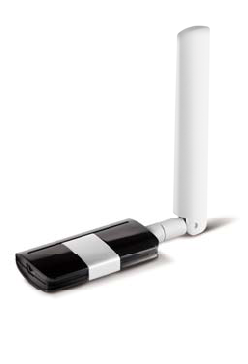
WU1112
User Manual
Version: 1.00

Table of Contents
Chapter 1: Introduction ……………………………... 1
1-1 Features................................................................1
1-2 Application...........................................................1
1-3 Package Contents.................................................2
1-4 System Requirements...........................................3
Chapter 2: Installation………………………....……3
Chapter 3: General Configuration……....…………9
3-1 Profile Management.………………………..... 9
3-2 Network Configuration Utility…………….… 11
3-3 Advanced Settings.……………………………14
3-4 Certificate Management………………………15
3-5 Wi-Fi Direct…………………………….…… 16
Appendix: Glossary ………………………………17
2

1
Chapter 1 INTRODUCTION
1.1 Feature
2.4Ghz ISM unlicensed band.
Compliant with IEEE 802.11n, IEEE 802.11g & IEEE 802.11b
Provides USB1.1/2.0 interface
Provides 150Mbps Uplink and 150Mbps Downlink data rate
Supports 20MHz/40MHz frequency width
Auto-detects and changes network transmission rate
Supports 64/128-bit WEP, WPA, WPA2 encryption methods
and 802.1x security authentication standard
Supports WMM for seamless voice and video transmission
Supports Windows XP, 2000, Vista & MAC etc.
1.2 Deployment
WU1112 Wireless USB Adapter offers a fast, reliable and
cost-effective solution for wireless access. Deployment as follows:
1. For company personnel who require wireless mobility and access to
network anywhere in the organization.
2. Enterprise or residential users who would like to convert from wired
to wireless network.
3. Limited budgets for cabling and particular locations such as hotels or
conference rooms where wired networking is not handy.

1.3 Package Contents
Please check the content of package for items described below:
- One WU1112
- One CD-ROM
If any of listed items are missing or damaged, please contact the
reseller or distributor from whom you purchased for replacement
immediately.
2

3
1.4 System Requirements
CPU : Pentium III 1G above or similar
Memory size : 256MB RAM
One CD-ROM Driver
Hard Disk : At least 100MB available space
One available USB 2.0 port (May not work on USB 1.1 port , and
performance will be greatly reduced)
Operation System : Windows 2000/XP/Vista/Win 7 ,Mac 10.4.x and
above or Linux.
Chapter 2 Installation Guide
This chapter will assist you in using the included CD-ROM for driver and
configuration utility installations. While installing the configuration utility,
the driver program will install automatically.
The following installation steps were based on Windows XP. Installation
steps on other operating systems please refer to the User Guide and the
instructions on OS to follow.
1. Insert the wireless USB adapter into the USB interface of your
computer.
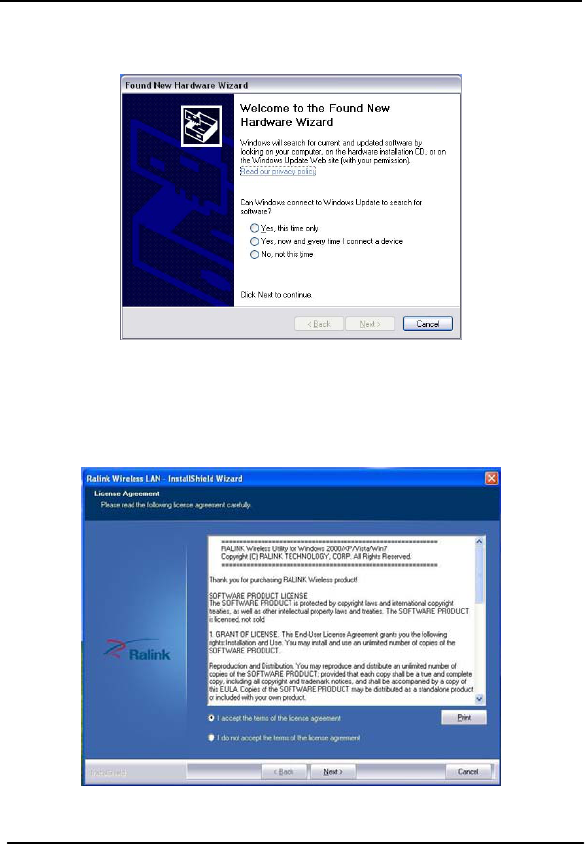
2. “Found New Hardware” system dialogue appears, and selects
“Cancel”.
3. Insert the included CD-ROM into the CD-ROM drive of your
computer, and the Welcome screen appears. (If not appear, double
click the “Setup.exe” icon.)
4
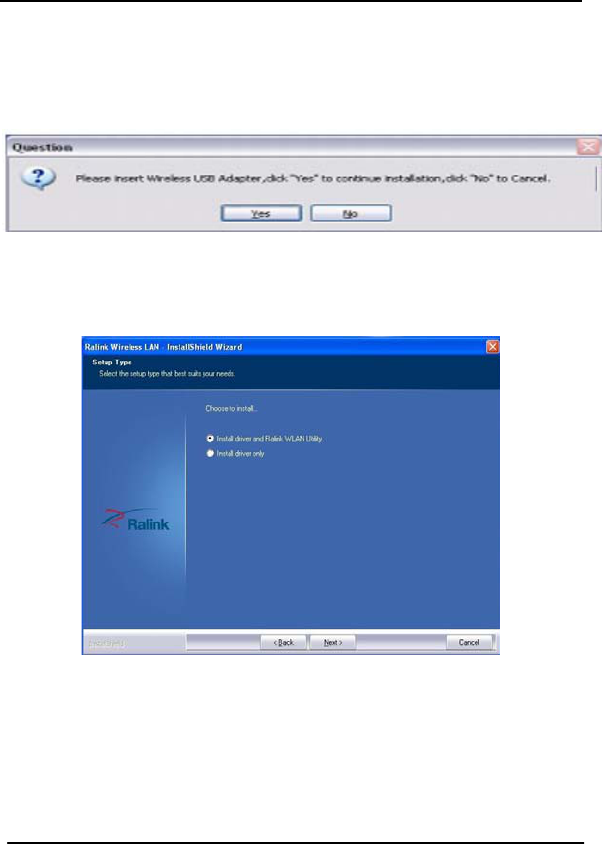
4. If there is no wireless USB adapter or incorrect connection, the
following window will appear. Click “Yes” to connect the wireless
USB adapter mentioned step 1.
5. Click “Install driver and Ralink WLAN Utility”, and then click “next” to
continue.
5
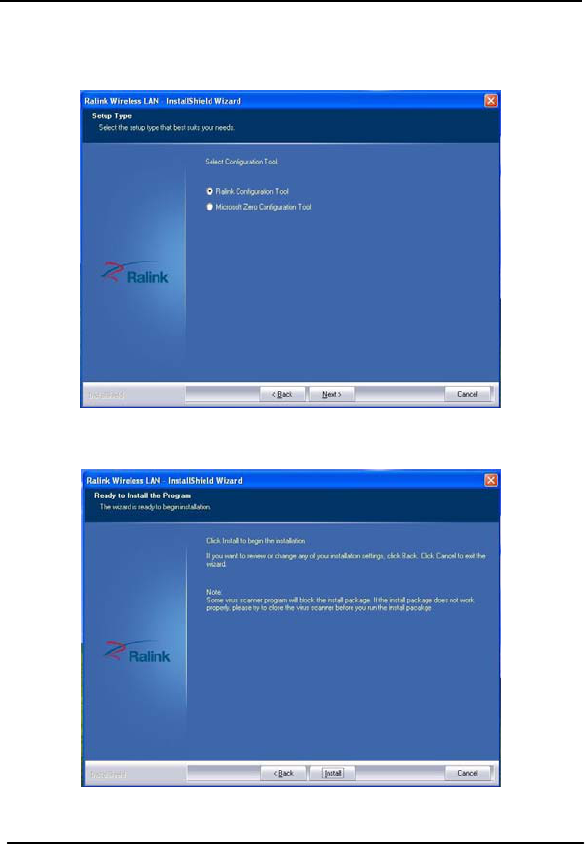
6. Click “Ralink Configuration Tool” or Click “Microsoft Zero
Configuration Tool”, and then click on “Next” to continue.
7. Click “Install” to start the installation.
6
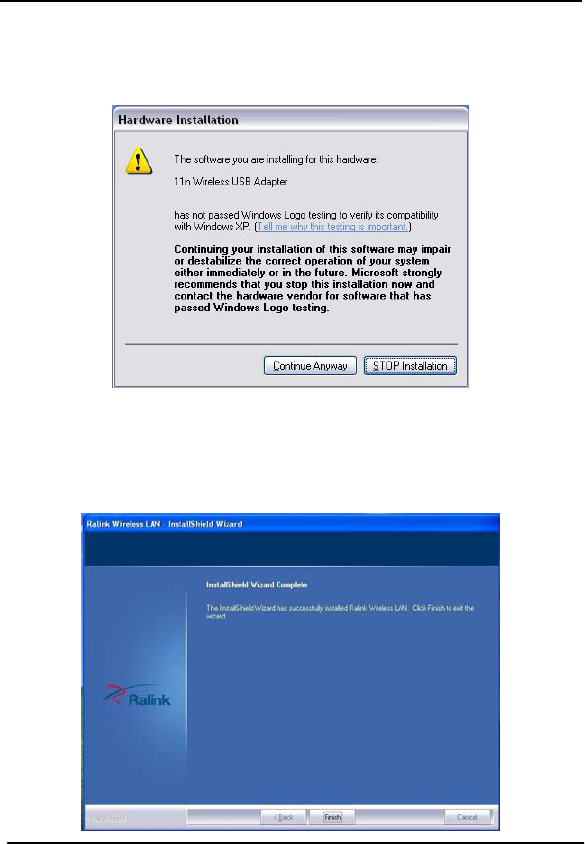
8. During the installation, the following dialogue maybe appears. Click
the “Continue Anyway” to continue. There is no security threat to
your computer.
9. Click “Finish” to complete the installation.
7
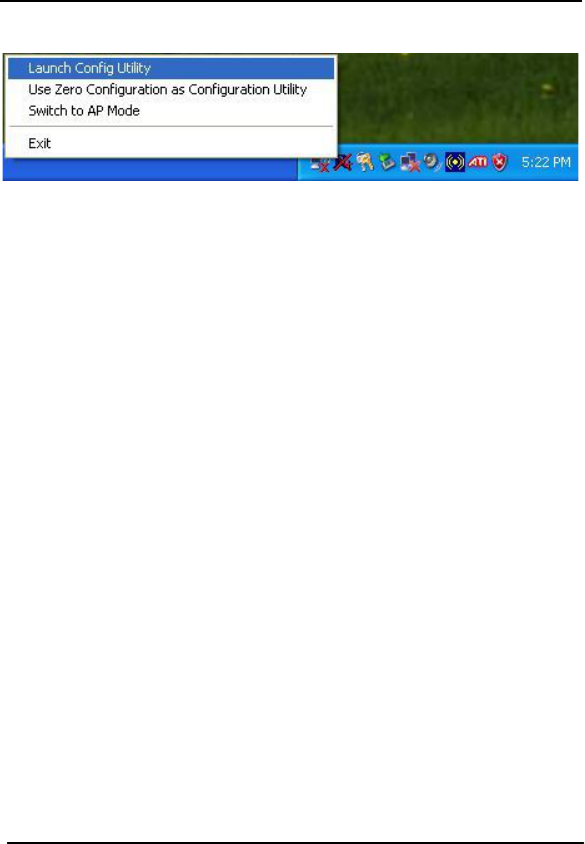
10. Right-Click on the “R” button and select “Launch Config Utility” to
start the software.
8
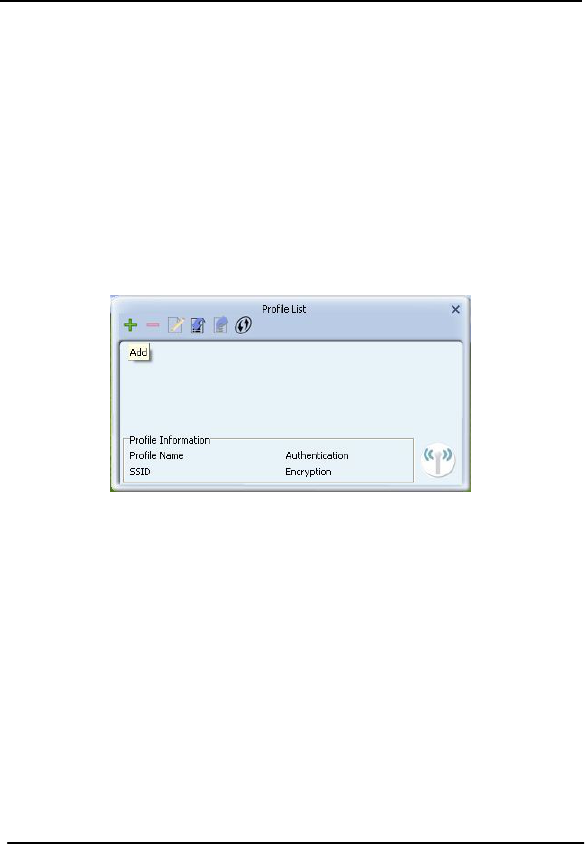
Chapter 3 How to Use the Wireless Utility Interface
(Client Mode)
This Utility Interface is provides basic configuration functions to WU1112
Wireless USB Adapter management. If the UI does not appear
automatically, please select from the CD to run the application.
3.1 Profile Management
9
Profile List
Profile can book keeping your favorite wireless setting among
your home, office, and other public hot-spot. You may save
multiple profiles, and activate the correct one at your preference
in the profile list.
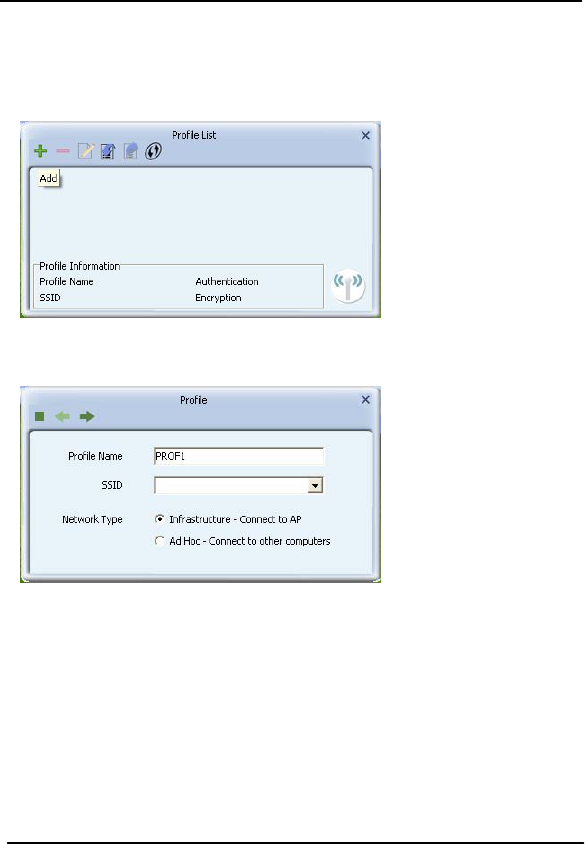
Add:
1. Click "Add" below the Profile List.
10
2. The "Add Profile" will appear.
3. Specify a Profile Name. Select an AP from the SSID drop-down list.
The AP list from the last Network.
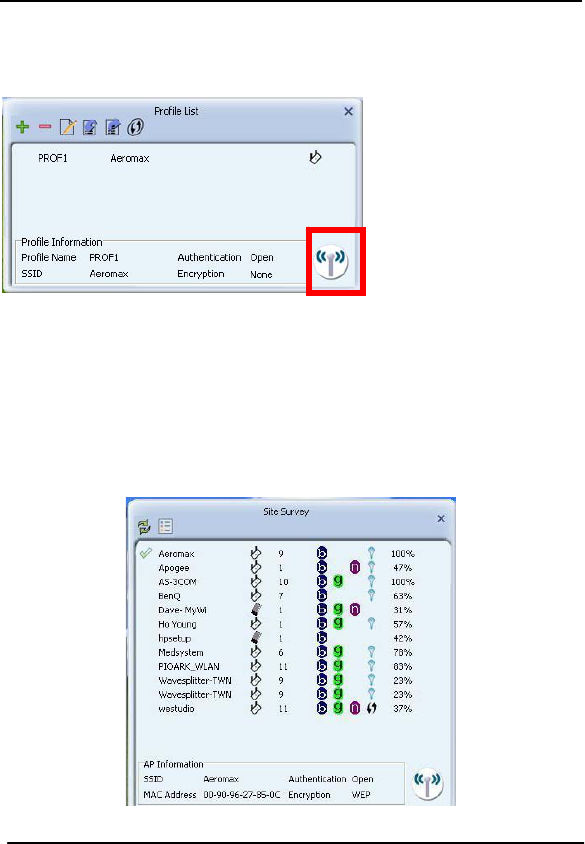
4. Now the profile which the user set appears in the profile list. Click
"Activate".
11
Network
The system will display the information of local APs from the last scan
result as part of the Network section. The Listed information includes the
SSID, MAC Address, Signal, Channel, Encryption algorithm,
Authentication and Network type.

Definition of each field :
1. SSID: Name of BSS or IBSS network.
2. Network Type: Network type in use, Infrastructure for BSS, Ad-Hoc for
IBSS network.
3. Channel: Channel in use.
4. Wireless Mode: AP support wireless mode. It may support 802.11a,
802.11b, 802.11g or 802.11n
wireless mode.
5. Security-Enable: Indicates if the AP provides a security-enabled
wireless network.
6. Signal: Receive signal strength of the specified network.
Icons and buttons :
Indicates that the connection is successful.
Indicates the network type is in infrastructure mode.
Indicates the network type is in Ad-hoc mode.
Indicates that the wireless network is security-enabled.
Indicates 802.11a wireless mode.
Indicates 802.11b wireless mode.
12
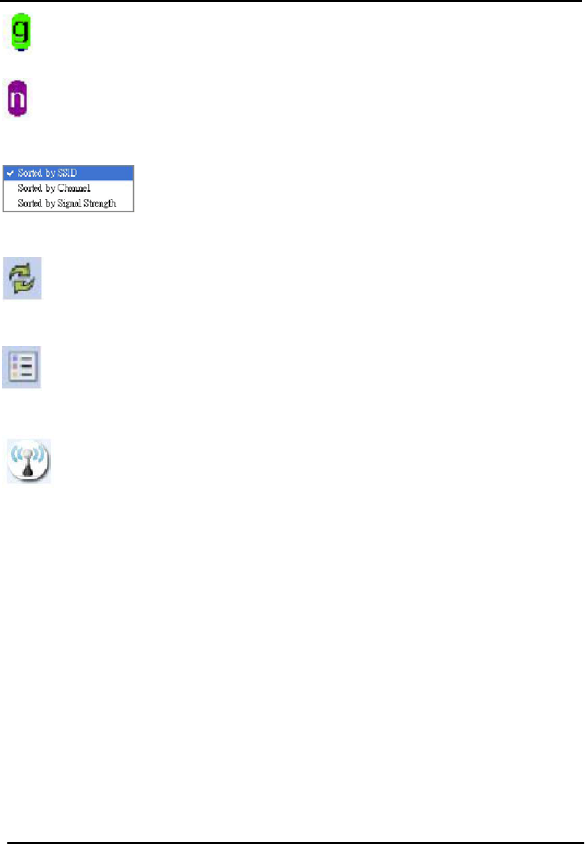
Indicates 802.11g wireless mode.
Indicates 802.11n wireless mode.
Indicates that the AP list is sorted by SSID, Channel or
Signal.
Issues a rescan command to the wireless NIC to update
information on the surrounding wireless network.
Adds the selected AP to the Profile setting. It will bring up a profile
page and save the user's setting to a new profile.
Button to connect to the selected network.
13
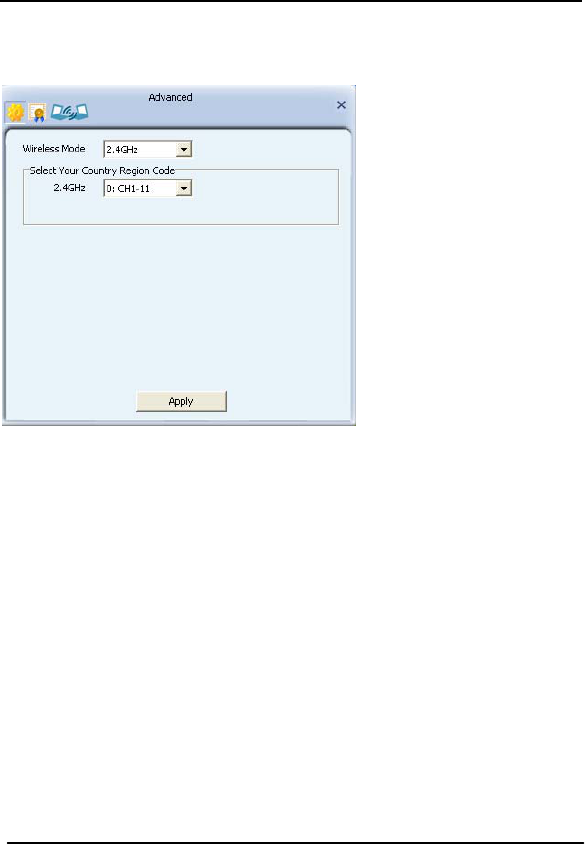
Advanced
1. Wireless mode: Select wireless mode. 2.4GHz, 5GHz and
2.4GHz+5GHz are supported.
2. Wireless Protection: Users can choose from Auto, On, and Off. (This
is not supported by 802.11n adapters.)
1. Auto: STA will dynamically change as AP announcement.
2. On: The frames are always sent with protection.
3. Off: The frames are always sent without protection.
3. TX Rate: Manually select the transfer rate. The default setting is auto.
(802.11n wireless cards do not allow the user to select the TX Rate.)
4. Select Your Country Region Code: There are eight countries to
choose from in the country channel list. (11A ListBox only shows for 5G
adapter.)
5. Apply the above changes.
14
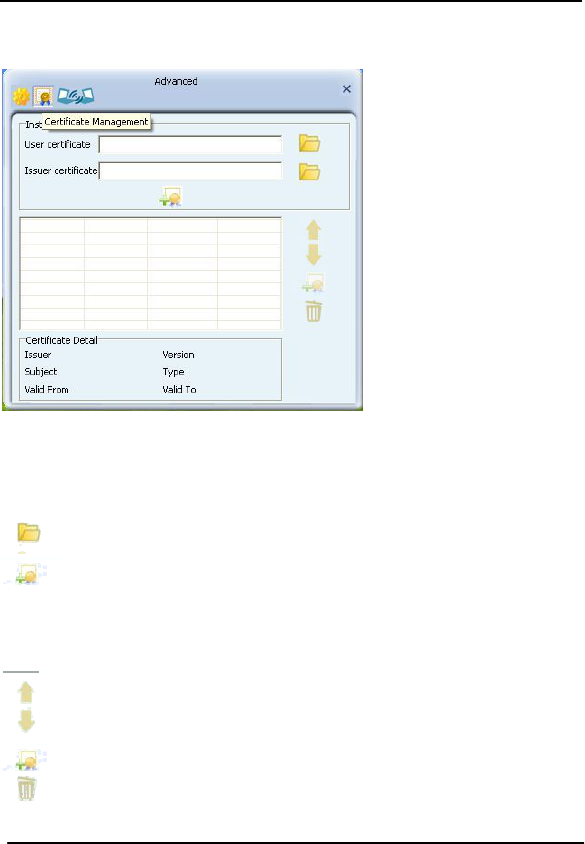
Certificate Management
1. Install Certificate :
Need to install user certificate and issuer certificate for the
authentication.
2. Icons and buttons :
Indicates to browser the file.
Indicates to install the certificate.
Certificate List :
Show all installed certificates. There are ordered property.
Icons and buttons :
Move up the selected certificate.
Move down the selected certificate.
Install AS certificate for the selected certificate.
Delete the selected certificate.
15
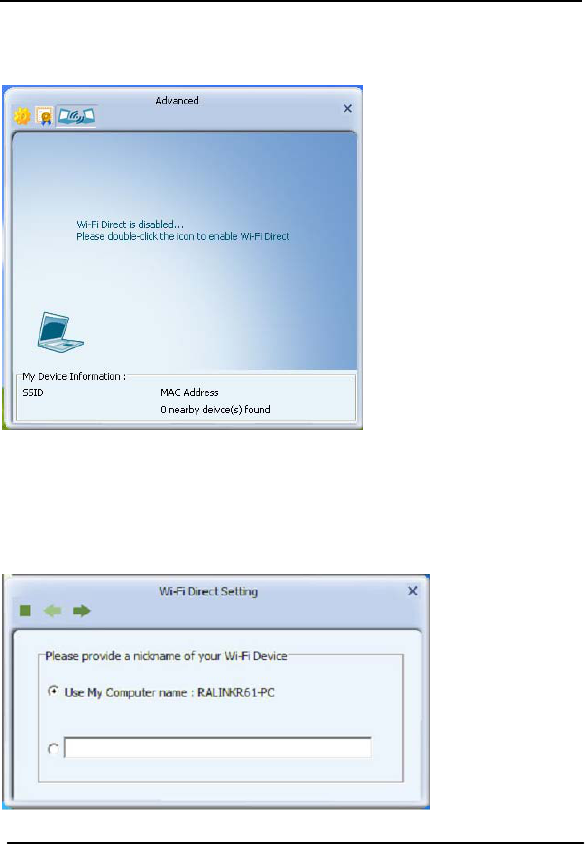
Wi-Fi Direct
Enable Wi-Fi Direct :
1. Need to double-click the notebook icon.
2. Specify the name of Wi-Fi Direct Device :
16
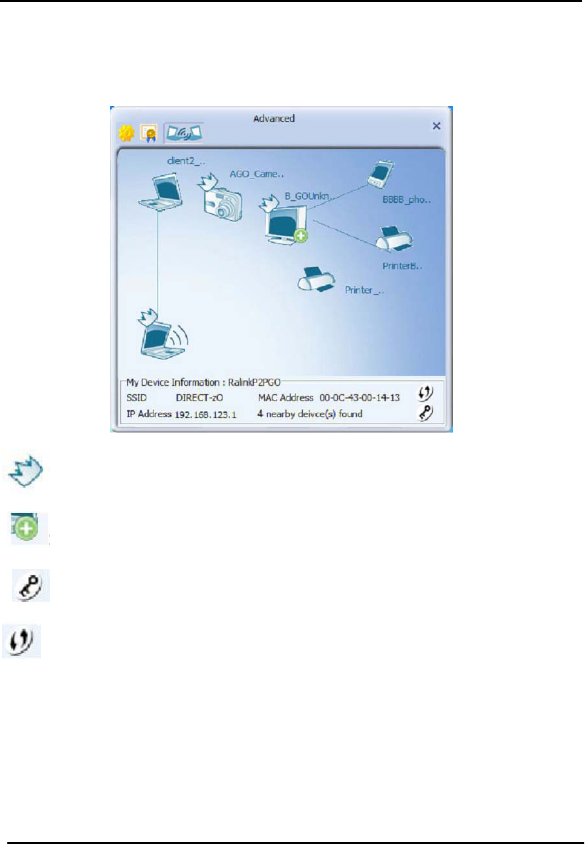
3. Ralink UI is able to discover other WiFi Direct topologies nearby
GO AP- like.
GO with clients in the same group
S key
r GO
Set WPA2PSK AE
configure WPS fo
17

18
Appendix One : Glossary
WLAN Wireless Local Area Network
802.11 A family of specifications developed by the IEEE for
WLAN technology.
802.11a An extension to 802.11 WLAN standard that provides up
to 54 Mbps transmission in the 5 GHz UNI radio band.
802.11b An extension to 802.11 WLAN standard that provides up
to 11 Mbps transmission in the 2.4 GHz ISM radio band.
802.11b uses DSSS modulation.
802.11g An extension to 802.11 WLAN standard that provides up
to 54 Mbps transmission in the 2.4 GHz ISM radio band.
802.11b uses OFDM modulation and is backwards
compatible with 802.11b.
Ad-Hoc A group of computers each with wireless adapters,
connected as an independent WLAN.
AES Advanced Encryption Standard
BSSID Basic Service Set ID
DHCP Dynamic Host Configuration Protocol
DSSS Direct Sequence Spread Spectrum. DSSS is one of
two types of spread spectrum radio. The other is
frequency-hopping spread spectrum(FHSS).
QoS Quality of Service
OFDM Orthogonal Frequency Division Multiplexing
RADIUS Remote Authentication Dial In User Service
RTS Request to Send
SSID Service Set Identifier. A 32-character unique
identifier attached to the header of packets sent

19
over a WLAN that acts as a password when a
mobile device tries to connect to the BSS.
TCP/IP Transmission Control Protocol/Internet Protocol
TKIP Temporal Key Integrity Protocol
WDS Wireless Distribution System
WEP Wired Equivalent Privacy. A security protocol for
WLANs defined in the IEEE 802.11 standard.
WPA Wi-Fi Protected Access
WPA2 Wi-Fi Protected Access 2. The next generation of
Wi-Fi security, based on the 802.11i standard.
WPA2-PSK Wi-Fi Protected Access 2-Pre-shared Keys
WPA-PSK Wi-Fi Protected Access-Pre-shared Keys

20
You are cautioned that changes or modifications not expressly approved by the
party responsible for
compliance could void your authority to operate the equipment.
This device complies with part 15 of the FCC Rules.
Operation is subject to the following two conditions:
(1) This device may not cause harmful interference, and
(2) this device must accept any interference received, including interference that
may cause undesired operation.
This equipment has been tested and found to comply with the limits for a Class B
digital device,
pursuant to part 15 of the FCC rules. These limits are designed to provide
reasonable protection
against harmful interference in a residential installation. This equipment generates,
uses and can
radiate radio frequency energy and, if not installed and used in accordance with
the instructions, may
cause harmful interference to radio communications. However, there is no
guarantee that interference
will not occur in a particular installation. If this equipment does cause harmful
interference to
radio or television reception, which can be determined by turning the equipment
off and on, the user
is encouraged to try to correct the interference by one or more of the following
measures:
-Reorient or relocate the receiving antenna.
-Increase the separation between the equipment and receiver.
-Connect the equipment into an outlet on a circuit different from that to which the
receiver is
connected.
-Consult the dealer or an experienced radio/TV technician for help.
FCC RF Radiation Exposure Statement:
1. This Transmitter must not be co-located or operating in conjunction with any
other antenna or transmitter.
2. This equipment complies with FCC RF radiation exposure limits set forth for an
uncontrolled environment. To maintain compliance with FCC RF exposure
compliance requirements, avoid direct contact to the transmitting antenna during
transmitting.